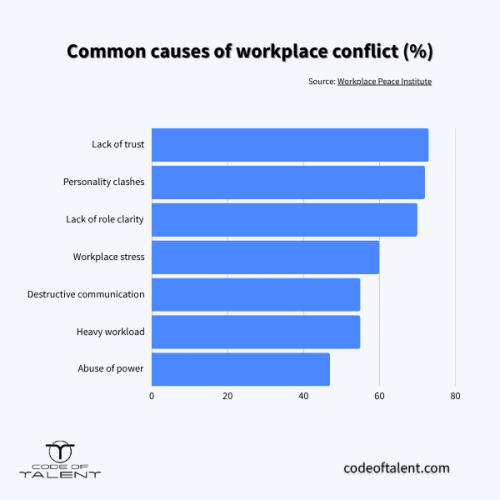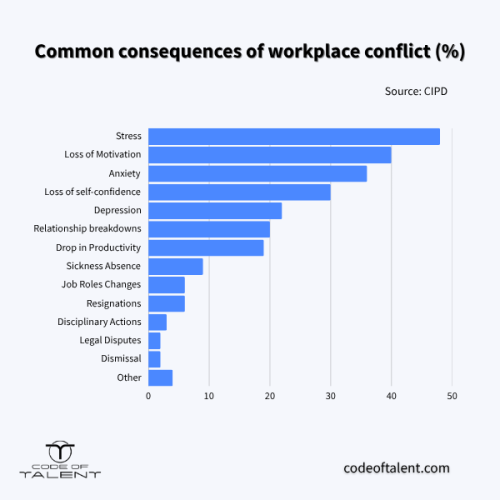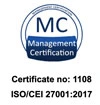U.S. employees spend an average of 2.8 hours per week managing conflict, costing businesses approximately $359 billion annually in paid hours. In the UK, conflict costs amount to £28.5 billion and about £1,000 per employee. In extreme cases, workplace tensions can escalate into serious violations of corporate policy or even legal issues. This is why, for managers, knowing how to deal with conflict in the workplace is not only a required skill but also a legal and moral obligation.
Contrary to popular belief, workplace conflict rarely resolves itself. Resolution requires psychologically proven strategies, and more importantly, prevention through consistent training for both managers and their teams.
This article offers a practical guide for managers on how to deal with conflict in the workplace, covering common triggers, and the role of training in prevention.
Common Causes of Workplace Conflict
Understanding the source of tension is essential to knowing how to deal with conflict in the workplace, no matter who’s involved. Misunderstandings and stress are often blamed for workplace conflict, but the issue goes deeper than that.
In many cases, the true cause might never be discovered due to the situation’s complexity or people’s fears and personal biases. That’s why it’s a manager’s responsibility to uncover what’s truly driving the tension and to make objective, informed decisions to resolve it.
According to a Workplace Peace Institute survey, respondents identified the following as common sources of workplace conflict (respondents could choose more than one):
- Lack of trust (73%)
- Personality clashes (72%)
- Lack of role clarity (70%)
- Workplace stress (60%)
- Destructive communication patterns (55%)
- Heavy workload (55%)
- Abuse of power (47%)
These numbers reveal a common theme: most workplace conflict comes from everyday issues like unclear expectations, poor communication, and unaddressed emotions, often built into the company’s culture itself.

The Human Impact
Beyond the scary numbers, another effect stems from workplace conflict, and possibly the most prevalent one: its impact on human behavior and relationships. In a survey by UK Chartered Institute of Personnel and Development (CIPD), respondents identified the following consequences of workplace conflict (respondents could select multiple options):
- Stress (48%)
- Loss of motivation (40%)
- Anxiety (36%)
- Loss of self-confidence (30%)
- Depression (22%)
- Relationship breakdowns (20%)
- Drop in productivity (19%)
- Sickness absence (9%)
- Changed job roles (6%)
- Resignations (5%)
- Disciplinary actions (3%)
- Legal disputes (2%)
- Dismissal (2%)
- Other (4%)

Impact on the Team
Only 22% of the surveyed people declared that conflicts had no impact on them, a relatively low number compared to the ones above. And the toll isn’t limited to individuals; it often spreads to the entire team:
- Stress, anxiety, and resentment can spill over to colleagues, even those not directly involved in the conflict.
- Team divisions may emerge, with individuals choosing sides and forming cliques.
- Isolation becomes common, as others may avoid those in conflict.
- Gossip and misinformation can spread fast. A study in the journal Sustainability found that negative gossip erodes trust and makes teams less willing to share knowledge, which hurts collaboration.
- Collaboration suffers, leading to missed deadlines, poor communication, and even structural changes within the team.
The Manager’s Role in Preventing Future Conflicts
In terms of conflict management, a manager’s job isn’t just to put out fires but also to prevent tensions from starting in the first place. Creating a safe, respectful, and communicative workplace is one of the most effective ways to reduce conflict.
Start with Transparency
Open communication helps uncover issues before they snowball. But the reality is, many employees don’t feel safe speaking up. A report by coaching and training firm Bravely found that 53% of employees deal with “toxic” situations by avoiding them entirely. This avoidance costs a company an average of $7,500 and over seven workdays per avoided conversation.
So how do you create a culture where conflict is addressed, not dodged?
- Hold regular one-on-ones: These check-ins are your chance to catch signs of tension early and build trust with your team.
- Be crystal clear on expectations: Misunderstandings around roles, responsibilities, and goals are main issues of team conflict. Clarifying these from the start can save you major headaches down the line.
- Be a good example: A strong, respectful team culture doesn’t happen by accident. Encourage collaboration and ongoing feedback and model the kind of communication you want to see.
Overlooked Solution: Soft Skills Training
When it comes to resolving conflict, most managers think of formal HR processes, disciplinary measures, or mediation sessions. But one of the most effective—and often overlooked—solutions is far simpler: soft skills training.
According to the Justice Institute of British Columbia, soft skills training leads to measurable improvements in:
- Productivity
- Team morale
- Innovation
- Workplace relationships
Why does it work?
Conflict is rarely about the surface issue. It’s about how people communicate under stress, how they listen (or don’t), and whether they can navigate disagreement without shutting down or lashing out.
That’s where soft skills training comes in. It can provide both managers and employees with the tools to prevent conflict, or at least de-escalate it before it spreads. Even in high-pressure industries like mining, studies have shown that soft skills training helped workers regain control in stressful situations, improving not just communication but overall workplace harmony.
- Active listening: Defuses emotionally charged interactions.
- Emotional intelligence: Helps manage interpersonal tension.
- Clear communication: Prevents misunderstandings.
- Empathy: Builds trust and openness.
- Problem-solving: Focuses energy on solutions.
- Negotiation: Encourages balanced outcomes.
- Self-regulation: Reduces reactive behavior.
- Constructive feedback: Promotes continuous improvement.
- Teamwork: Aligns individuals with collective goals.
Step-by-Step Guide on Mitigating Conflict as a Manager
Even with the best prevention strategies, conflict can still arise. Every manager has their own style of handling disputes, shaped by personality, experience, and team culture. But no matter your approach, two things are essential: staying objective and using a structured process.
Focus on four key phases:
- Listen
- Analyze
- Solve
- Follow Up
Below is a practical, step-by-step guide on how to deal with conflict in the workplace using these four pillars.
1. Get the Basic Information
Start by gathering the basic facts to form a general picture of what happened. This isn’t the time to dive deep into emotional details; focus on the objective information:
- When and where it happened
- Who was involved (directly or indirectly)
- Whether others witnessed the incident
- What happened, specifically (e.g., an email exchange, a missed deadline, a policy violation)
- What happened afterward, including impacts on clients, team morale, or workflows
- Any tangible evidence, such as emails, chat logs, or documentation
2. Escalate if Necessary
Some conflicts fall outside a manager’s scope and must be escalated immediately to HR, legal, or—if urgent—to external authorities. These include:
- Violence (physical or verbal)
- Harassment (sexual, racial, psychological, etc.)
- Property damage
- Security breaches (physical or digital)
- Data protection violations
These escalations not only harm individuals but can also have significant financial and reputational repercussions for organizations. According to the International Labour Organization, violence and harassment at work have affected more than one in five people globally. In the U.S., workplace violence incidents have led to significant financial losses, with estimates suggesting costs of up to $56 billion annually.
3. Listen to Everyone, Separately
Hold individual conversations with each party involved. These should be private, judgment-free spaces where people feel safe sharing their side of the story. Focus on:
- Letting them speak without interruption
- Asking clarifying questions, not accusatory ones
- Taking notes
- Avoiding assumptions or jumping to conclusions
It’s important to hear everyone out individually, as many people are intimidated by the presence of the other involved parties. This way you can also spot inconsistencies and similarities between people’s claims.
4. Observe Emotional Cues
Pay attention to what’s not being said. Body language, tone, and even pauses can reveal more than words. Look for signs of:
- Frustration (short answers, sarcasm, closed-off posture)
- Distress (tearfulness, withdrawal, fidgeting)
- Resentment (blame-shifting, passive-aggressive language)
Noticing these emotional signals helps you better understand the deeper layers of the conflict and adjust your tone or pace to make the person feel heard and safe.
5. Analyze Objectively
Now that you’ve gathered all perspectives and emotional context, take a step back. Review the facts and evidence with an impartial lens:
- Identify common threads and points of disagreement
- Consider if the issue is a one-time clash or a symptom of a deeper problem (e.g., unclear roles, poor communication, burnout)
- Separate emotional reactions from organizational impact
The goal here is to understand why the conflict occurred, not just what happened, so you can address the root cause, not just the symptoms.
6. Brainstorm Solutions
Once you’ve understood the situation, guide the conversation toward actionable outcomes. Emphasize solutions that are realistic, measurable, and agreed upon by all parties.
You can use the Thomas-Kilmann Conflict Mode Instrument to adapt your approach based on how individuals typically respond to conflict:
- Competing: Offer clear direction backed by data and policy.
- Collaborating: Involve them in building a win-win solution together.
- Avoiding: Create a low-pressure environment and encourage them to voice concerns.
- Accommodating: Help them express their needs and reinforce that their perspective matters too.
- Compromising: Guide the team toward a middle ground that balances fairness with efficiency.
7. Discuss Together
Bring the involved parties together with a clear plan. As a manager, you act as a neutral facilitator, setting the tone and structure. Before the meeting:
- Share discussion goals ahead of time
- Establish ground rules (e.g., no interruptions, speak respectfully)
- Prepare to redirect if emotions run high
- Keep the session constructive and focused on resolution, not rehashing the conflict.
After the meeting, summarize key takeaways and decisions in writing. Include:
- Agreed-upon actions or behavior changes
- Responsibilities and timelines
- Any follow-up steps
8. Agree on a Resolution
Make sure everyone leaves the conversation with clarity. If you’re unable to come to an agreed conclusion, organize another meeting (hopefully after things settled down and tensions lowered). Talk until everyone is on the same page. During the resolution, reconfirm:
- What will change
- Who’s responsible for what
- How you’ll measure success
9. Follow Up
Even when parties agree to a solution, conflicts can linger deep within team dynamics. This is why it’s important to revisit the issue after an agreed time frame—usually within 1–2 weeks. Meet privately to ask:
- Is the situation improving?
- Have expectations been followed through?
- Are any tensions lingering?
In this meeting, you’ll notice emotional cues that will indicate whether the conflict still exists, perhaps hidden beneath compliance. Adjust the plan if needed and continue monitoring until the situation stabilizes.
10. Understand the Broader Context
While the conflict may be resolved, its occurrence has likely highlighted deeper issues within the team or the company’s culture. Take a step back to see the bigger picture, as identifying recurring patterns can help prevent future escalations.
Does this conflict point to:
- A culture of poor feedback?
- Chronic miscommunication?
- Role or workflow confusion?
11. Recommend Relevant Training
Request additional training that targets the emotional triggers that may cause future conflicts. Soft skills training is not only for mitigating conflicts, but for behavioral changes that make us more receptive to change, opposite views, and tense situations.
Consider including the following in your training plan:
- Effective communication
- Team collaboration
- Constructive feedback
- Emotional regulation
- Conflict de-escalation techniques
Even a few hours of training can shift team dynamics and reduce future friction.
Workplace Conflict Prevention Strategy
Effective conflict resolution is an essential skill for every manager. With the right approach, such as listening, analyzing, and implementing clear solutions, you can turn challenging situations into opportunities for growth and improvement within your team.
When it comes to prevention, a suitable training platform is the way to go. Code of Talent support managers in mitigating and preventing conflicts in the workplace in two ways:
- Empowers managers to improve their conflict management skills
- Develops their teams’ communication and collaboration abilities
Code of Talent’s features include:
- Personalized learning experiences
- Scenario-based exercises
- Collaborative learning
- Microlearning for better information retention
- Gamification for a more engaging experience
- Real-time tracking
How to Deal with Conflict in the Workplace Worksheet for Managers
To help you apply the steps outlined in this article, we’ve created a downloadable worksheet that allows you to easily track and document conflict resolution efforts.
Try Code of Talent for free to learn how to deal with conflict in the workplace and mitigate future issues.
Cover photo: Freepik





